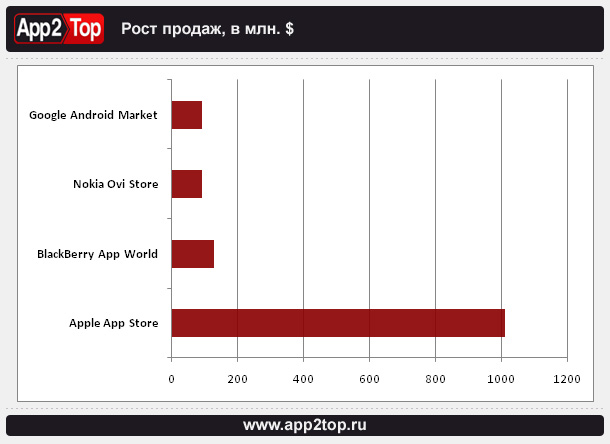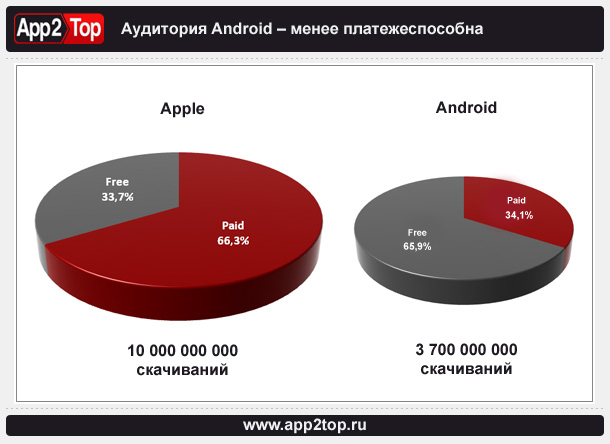This question worries equally those who are just going to make their first mobile application, and those who have already achieved success with applications on the iOS platform. Does the popularity of Android devices mean a commensurate profit for developers?
Naturally, it is impossible to talk about Android without comparing it with the most profitable iOS application market for developers. Despite the conclusion about the popularity of the Android platform among buyers, the statistics of purchases of paid applications looks simply knockout for Apple’s competitors:

What do we see? Some “pathetic” $11 million for Android against $769 million for Apple in 2009 and $102 million against $1.78 billion, respectively. Market shares are distributed approximately as follows:


Yes, the percentage increase in Android, for example, from 2009 is 920%, which is very, very much, but, you must agree, in absolute numbers, statistics for Android looks depressing.
What is the reason for this? And in this case, what should Android app developers and Apple developers do, who strive to cover all markets?
First of all, if you look at the numbers, you can conclude that the Android audience is less solvent. Which is quite understandable if we recall that Apple has been presenting its products as premium products from the very beginning – iPhone and iPad devices are not for the poor.
The second, no less compelling reason for the low sales of applications in Android is the lack of the need to link a plastic card and, as a result, the inability to download a paid application without going through this procedure for an ordinary buyer.
What this leads to – see below:

What should developers do?
Many developers are looking for alternative ways to solve the problem of monetization of their applications, which have spent effort and money. One of the ways to monetize applications for Android developers is to transfer their applications to a free basis with the location of internal advertising by third–party companies. This was done by the well-known company Rovio, the developer of the sensational AngryBirds, which was transferred to this method of monetization. However, to the chagrin of the company, the profit at the moment is not even close to comparable with sales on Apple devices.
The second, effective, but not yet widely used method among developers is to pay for applications and add–ons in freemium mode directly from a mobile phone account (which Rovio came to use in an evolutionary way). Via SMS or mobile payment. This will provide an opportunity for the developer to increase profits at times, and for the user to get the desired application, very easily paying for it after launch.
The main issue here is the financial side. It is known that Google withholds a commission of 30% from payments. When users pay via SMS, the commission from payments will be higher, about 40-50% on average, however, the number of payments may increase by an order of magnitude. As for mobile payments – the situation is even more advantageous for developers than settlements with Google – the commission from the payment usually ranges from 25% to 30%, depending on turnover.
Anyway, the mobile app market continues to develop rapidly, and mobile app developers have high hopes for Android apps. Whether they will be justified or not, it will become clear after a while.
However, do not think that by making an iPhone app now, you can get rich quickly – you can read the calculations of how much “average” companies earn (we do not take into account super-famous brands) on the Apple App Store in the next article.
